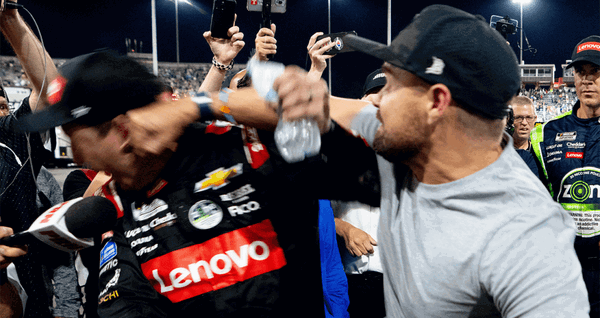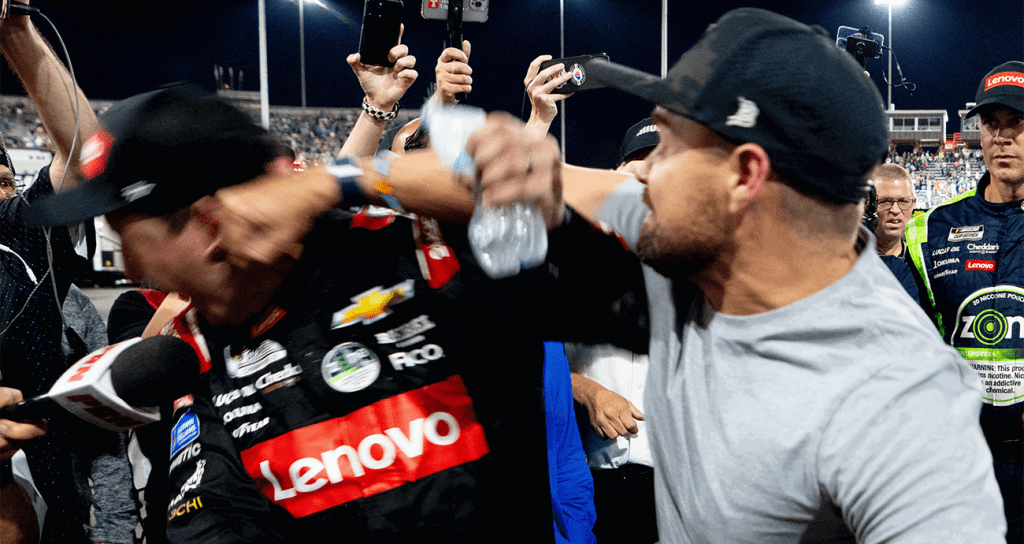

Back in NASCAR’s wilder days, fights were almost as legendary as the racing itself, and fans absolutely loved it. One of the most iconic came at the 1979 Daytona 500, when Cale Yarborough and Donnie and Bobby Allison threw punches on the frontstretch after a last-lap crash, all live on national TV. But while those fights were iconic, NASCAR has long faced scrutiny for how it handles driver penalties after on-track altercations and post-race fights.
Watch What’s Trending Now!
The sanctioning body often emphasizes that each situation is judged individually, but the lack of clear, consistent standards has fueled debate within the garage. Some incidents have resulted in heavy fines or probation, while others with similar levels of aggression have gone unpunished. NASCAR officials say decisions depend on “intent” and “actions that escalate danger,” yet the true boundary is still uncertain, creating a gray area that drivers navigate carefully today. But reporter Jordan Bianchi had a fresh take on this, implying how the act of fining drivers exposes NASCAR’s double standards.
ADVERTISEMENT
Bianchi calls out NASCAR’s fight fines as hypocritical
When veteran NASCAR reporter Jordan Bianchi took to The Teardown Podcast to discuss the sport’s recent disciplinary actions, he didn’t hold back. “This is a pet peeve of mine,” Bianchi said. “We’re not going to fine, we’re not going for fighting anymore, like not doing it for drivers, crew guys, stuff like that. I get it. I wrote about this on The Athletic, how NASCAR handles post-race fights.
They don’t want crew guys getting involved for a lot of reasons. I’m great with that. We don’t want that. I’ll take that back, we do want every once in a while, we brawl. It’s not bad for business.” His comments reflect a growing debate in the NASCAR community over where the line between discipline and entertainment should be drawn.
Bianchi’s main point centered around what he considers a double standard. “It makes sense, guys can get hurt,” he said. “But if Ricky Stenhouse Jr. is going to pop Kyle Busch, I’m not fining him $75,000. Hell, I’m probably gonna pay him $75,000 for that and go, ‘Here’s your check, thank you!’ You just got us on every national outlet in the country, and we’re not going to embarrass you by fining you 75 grand.”
ADVERTISEMENT
His comments came in the wake of NASCAR’s $75,000 fine against Stenhouse for punching Kyle Busch at North Wilkesboro after the 2024 All-Star Race, an incident that became one of the sport’s most viral moments of the year.
Beyond the penalty itself, Bianchi argued that NASCAR’s messaging to sponsors and fans has been inconsistent. “Which, by the way, pisses off your sponsor,” he said. “Your sponsor is like, ‘Oh man, that makes us look bad.’ Like, no, we’re going to celebrate it. We’re going to make you look like a badass, and your sponsor’s going to be like, ‘Yeah, that’s my guy.’” His frustration highlights how the sport’s marketing often capitalizes on conflict while simultaneously punishing the behavior that fuels fan engagement.
ADVERTISEMENT
“It really bothers me, so hypocritical,” Bianchi continued. “You can’t sit there and say, ‘Man, that was wrong, we’re going to penalize you for that,’ but then turn around and use it to hype up the race. You can’t have it both ways.”
The sentiment echoed the thoughts of many longtime fans who believe that controlled emotion, like fights or heated rivalries, has always been part of NASCAR’s DNA, tracing back to iconic moments such as the 1979 Daytona 500 brawl between Cale Yarborough and the Allison brothers.
Bianchi clarified that he’s not advocating chaos, just perspective. “If two drivers are fighting and the guy gets popped, cool, I’m fine with that. There’s a line, obviously, but that’s not the line. And it sure as hell wasn’t worth $75,000.
ADVERTISEMENT
We just need to re-modify that a little bit.” His stance underscores that NASCAR’s punishments should fit the context, especially when such altercations bring unprecedented media attention.
“It drives me crazy that the crash from 10 years ago at Martinsville, Matt Kenseth and Joey Logano, that earned Kenseth a two-race suspension, justifiably so, by the way, they used that to sell that race,” Bianchi concluded. His reference to the infamous 2015 Martinsville incident, where Kenseth deliberately wrecked Joey Logano during the playoffs, points to a recurring contradiction: NASCAR’s willingness to turn its most controversial moments into marketing gold.
But while Bianchi pointed NASCAR’s penalty problems, Kevin Harvick shared his views on NASCAR’s superspeedway issue.
ADVERTISEMENT
Harvick on NASCAR’s superspeedway opinion
The Kevin Harvick Daytona verdict has reignited discussions about the current state of NASCAR superspeedway racing, following his public praise for the recent Daytona event and a critique of the series’ recent races. With NASCAR maintaining its existing technical package for superspeedways into the near future, questions remain about how future events will keep fans engaged and deliver exciting finishes.
Recent NASCAR superspeedway events have received criticism for lacking excitement, a sentiment shared by both fans and industry insiders. Racing at these tracks has been described as overly calculated, with competitors prioritizing fuel conservation and strategic riding over overt battles for position. Packs of cars often cruise together at less than full throttle, resulting in less genuine side-by-side action. Even when cars spread out three or four-wide, it has become more about managing space than aggressive competition.
This trend has been largely attributed to the reduced horsepower associated with the current Next Gen car specifications. With lower engine power, cars tend to form dense groups, significantly limiting opportunities for drivers to break free and make passes. When an incident occurs at the front of the pack, the tight formation can quickly turn minor mistakes into multi-car accidents, removing many contenders at once.
NASCAR’s announcement to increase horsepower at certain tracks next season excludes superspeedways, including iconic venues like Daytona, which means these venues will continue using the current configuration at least through the upcoming schedules. As a result, there is skepticism about whether the issues affecting the superspeedway spectacle will be resolved soon.
Despite widespread criticism, this year’s regular-season finale at Daytona stood out as a rare example of thrilling competition. Kevin Harvick, an experienced driver and respected commentator, identified the 2025 Coke Zero Sugar 400 as the season’s most exciting superspeedway race, pointing to Ryan Blaney’s dramatic drive from 13th place to victory in the closing laps as the kind of action fans crave. Harvick told his co-hosts at Kevin Harvick’s Happy Hour.
“Yeah, they were getting after it from the top. And this, from the start to the finish, was the best complete Super Speedway race that they have. And we talked about this. Obviously, Ryan Blaney comes on at the end right here to win this race from deep in the field.”
The battle for the lead in the final laps, against a backdrop of recent races dominated by processional running and minimal passing, captured what many, including Harvick himself, believe should be a blueprint for exciting superspeedway competition.
ADVERTISEMENT
ADVERTISEMENT
ADVERTISEMENT

